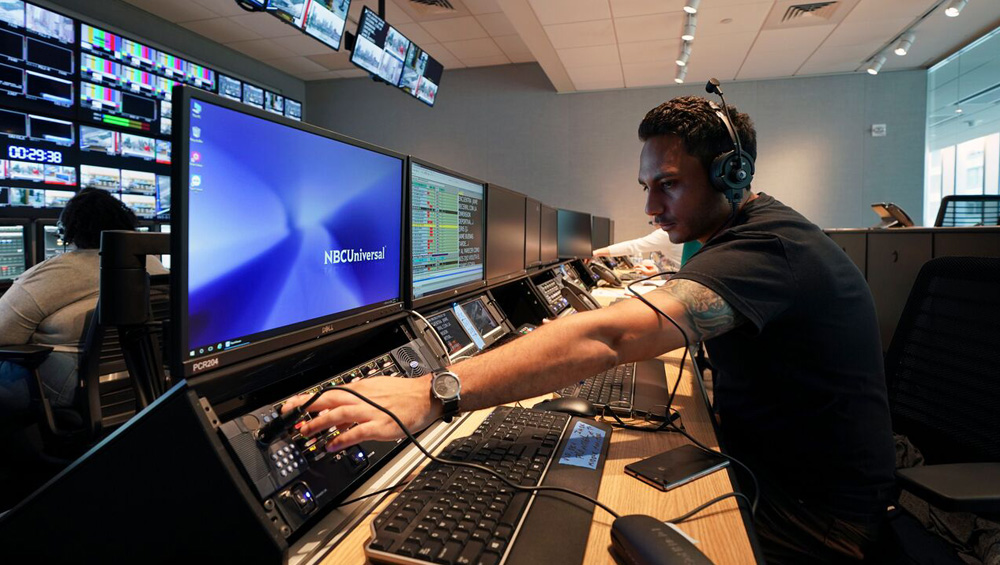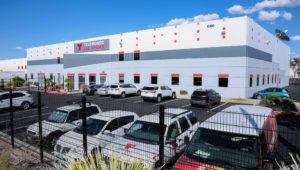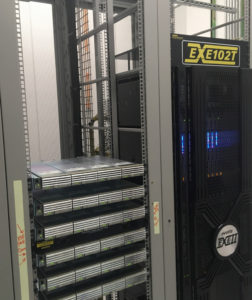
TVN Tech | Routing Vendors Eye IP Growth

The broadcast industry’s migration from HD-SDI routing to IP infrastructures is advancing steadily, less than two years after the formalization of the SMPTE ST 2110 standard for moving content over IP networks.
Big networks and sports broadcasters are leading the way, with several large IP-centric facilities already on-air and a host of projects underway both domestically and overseas. Local stations are now starting to invest in IP routing, though vendors expect their migration to be more gradual and caution that SDI is far from dead.

Imagine Communications’ John Mailhot
Business need has been driving IP investment to date, with some large networks overhauling their technical infrastructures due to real estate moves, such as NBCUniversal’s new Telemundo Center in Miami or CNN’s new headquarters at 30 Hudson Yards in New York. Others are upgrading existing facilities to support 4K UHD production, such as QVC Japan.
For Imagine Communications, the IP business internationally is “pretty brisk” with multiple projects underway, says John Mailhot, CTO of networking and infrastructure.
“It seems every country has got a project going on,” says Mailhot, who notes that QVC Japan was Imagine’s first big ST 2110 installation.
“The phenomenon of real-estate driven transactions is very high worldwide,” he adds. “The TV industry traditionally has big campuses, and a lot of times the building is worth a lot of money. Corporations are looking to monetize the land under the building, and that means an upheaval of the technical infrastructure.”
Chuck Meyer, Grass Valley CTO-Live, says his company is “pretty pleased” with the pace of the IP transition so far. Grass Valley provided the IP routing system, using Cisco switches, for the all-IP facility the NBCUniversal Owned Television Stations group built last year in Philadelphia for WCAU-WWSI, its duopoly there. Grass Valley is currently in the closing stages of a multi-year project to provide an IT routing infrastructure for BBC Wales’ new headquarters in Cardiff and is also involved in a number of mobile production projects, Meyer says.
[Editor’s note: Grass Valley parent company Belden Inc. announced in late October that it would be selling the business; the likely buyer is a private equity firm. For its part, Grass Valley says the move will not disrupt its current operations and that current management will remain in place.]
“The conversation is now very commonly about IP, not why I need it or if I need it,” Meyer says. “It’s kind of a foregone conclusion that’s the way it’s going, and I think we’ll see more and more projects. But we’re still at the point where a project will be newsworthy simply because the project is IP.”
Varying Architectures
Imagine and Grass Valley both make IP routing control software — the Imagine Magellan SDN and Grass Valley GV Convergent systems, respectively — that works with common-off-the-shelf (COTS) hardware from Cisco and Arista. Evertz, which provided the routing infrastructure for the new Telemundo and CNN ST 2110 plants and also has a number of IT routing installations using its proprietary ASPEN networking protocol, has a different approach. It sells its Magnum control software to run its “EXE” IP switches, which it manufactures itself.
IP routing architectures vary, Meyer says. Most large facilities with a lot of inputs and outputs are opting for a “big core router” approach, while facilities with a smaller number of inputs and outputs might employ a spine-and-leaf architecture.
“Most of what you’ll see, whether it’s Cisco or Arista, is a tendency toward a core router,” Meyer says. “It’s a little more familiar topology. If you think of a 1000-square [1000 x 1000] HD-SDI router, it’s similar to that.”
Grass Valley doesn’t see any big difference in making its software work on either Cisco or Arista hardware, and Meyer says it’s simply a matter of customer preference.

NBCU’s new WCAU-WWSI facility in Philadelphia is IP-centric and is designed to not only give the two stations a more efficient space with a common technology infrastructure, but to give their personnel new flexibility in creating content for today’s multiplatform world.
Mo Goyal, Evertz’s senior director of international business development, live media production, says the company learned from early IP installations like ESPN that it needed to fine-tune IP switching to address broadcast priorities like latency and accuracy. It decided it would be easier to build its own switches than try to tweak third-party products.
“Our architecture is unique, in terms of the cross points,” Goyal says. “The way we build SDI routers, there is a fundamental benefit to that architecture, so we said let’s make it work in IP.”
Cost Savings Potential
IP makes sense for big facilities and mobile trucks, which can see significant cost savings, Goyal says. It also readies them for producing in scale at 4K, which at 2180p60 equates to a data rate of 12 gigabits uncompressed. And there’s been a steady drop in the cost of IP systems, as more and more vendors roll out products.
That said, Evertz still sees “a very healthy SDI market right now,” Goyal says.
“For a smaller facility, the current cost of 3-gig routers is fairly attractive,” he says. “For IP, the tipping point is still fairly high, the cost is still fairly high versus an HD-SDI matrix. A 32 x 32 SDI router, you can buy fairly cheap versus building an IP gateway and network.”

Grass Valley’s Chuck Meyer
The relative cost of IP depends on the size of the router needed. If a big facility needs an 1152 x 1152 router, then IP is the way to go, Goyal says. But the cost benefits of IP aren’t as clear for mid-tier and small facilities, which has some sticking to the SDI path.
“When you look at why you’re going down the IP road … it is to be futureproof,” Goyal says.
He notes some smaller stations need to ask themselves about the likelihood of going beyond HD, and whether they’re going to do 4K in the next five years. If they are, how big a part of the facility are they going to build for 4K?
“Those are the conversations midsized and smaller broadcasters have to go through to justify the path of going IP,” he says.
One of the key reasons for stations not to rush into IP is that many of them already bought 3-gigabit-per-second HD-SDI routers in their last round of HD investment. Goyal says that Evertz sold a lot of 3-gig routers about five years ago and estimates that less than 50% of the customer base only has a 1.5-gig HD-SDI router. Meyer says any HD-SDI router Grass Valley sold in the last seven years has a 3-gig chipset.
And it’s possible that those stations could support limited 4K production by splitting a 12-gig 4K signal into four 3-gig chunks and interleaving them, Meyer says. SMPTE is currently considering this technique under the Recommended Practice ST 2110-23: “Single Video Essence Transport over Multiple ST 2110-20 Streams.”

CNN’s new headquarters at 30 Hudson Yards in New York was the first major broadcast facility to be completely based on the SMPTE 2110 IP networking standard.
More important, those 3-gig HD-SDI routers are also capable of doing 1080p production with High Dynamic Range (HDR), which many broadcasters see as a more practical upgrade from standard 720p or 1080i HD than going to full 4K. While many expect major sports production to eventually go 4K — and there are already some early 4K sports broadcasts from Fox and ESPN on DirecTV and other pay TV platforms — other content, particularly local news, remains a big question mark.
“There’s a lot of interest to stay in the 1080p HDR format,” Meyer says. “Both in Europe and the U.S., there’s a pretty big percentage of the market that is interested in doing that.”
That’s because research has shown that HDR has more impact with consumers than increased resolution, and going up to 1080p HDR is much less expensive than going to 4K HDR.
While the ATSC 3.0 next-gen standard will support 4K broadcasts, the ROI on stepping up to 4K resolution for U.S. broadcasters is debatable, particularly when one considers that the lion’s share of the audience today still watches broadcast content through cable and satellite operators that recompress stations’ signals for final delivery to the home.
“I’m a big proponent of 1080p HDR,” says one technology executive at a major network, speaking on background. “The infrastructure is really expensive to go 4K for production for a very limited ROI, or even a negative ROI.”
The executive notes the high storage costs of 4K, and worries about the efficiency of moving large files quickly for news production, which is “all about speed.”
At TVNewsCheck’s TV2020 conference last month, executives from station groups Sinclair Broadcast Group and Hearst Television noted there isn’t a pressing business need to move to IP routing at their stations and questioned whether they would ever produce 4K news. Mailhot concedes that for many broadcasters, “HD-SDI might be the right technology for a long time.”
“If an HD-SDI refresh is what you need, and they still make HD-SDI routers, it will work great, and the cost point will be really attractive,” he says. “The state of HD-SDI routing is the best it’s ever been. If you look at the project cost for a small-to mid-market TV station to put in a new HD-SDI router with MADI (audio), it’s pretty straightforward. There’s no sin in doing HD-SDI. It’s a fine technology, and we still make and sell it every day.”
A Reinvestment Inflection Point
While HD-SDI routing may be adequate for years, existing gear obviously won’t work forever. Most of the HD-SDI routing equipment that stations bought is seven to 10 years old, and in some cases it’s fully depreciated. In others it’s simply nearing its end-of-life, a date that is effectively being moved up by manufacturers’ changed priorities.
Jason Kornweiss, VP and GM of emerging technology and solutions for leading systems integrator Diversified, says that stations with eight-to-10-year old HD-SDI gear are at “an inflection point” of needing to reinvest.

Telemundo’s KBLR Las Vegas has a new IP-based facility that is almost completely driven by equipment housed in an off-site data center.
“What is forcing end-of-life faster is the manufacturers themselves,” Kornweiss says. “They’re all being directed to reinvest internal dollars to the IP space, and they’re focusing their internal efforts on driving IP while still trying to maintain the SDI gear that’s out there.”
Karl Paulsen, chief technology officer for Diversified, notes that customers’ SDI plans may depend on how many spare parts they can accumulate before manufacturers stop making them. His advice to small to mid-size broadcasters is to “start planning to go IP two years from now, because it will take you two years from now to get there.”
Smaller broadcasters looking to make a technology investment are often unsure of what is the right strategy, and sometimes make inaccurate assumptions about the relative cost of different technologies.
Kornweiss says Diversified is having such a conversation with a customer right now. “They say: ‘We know we’re not going to go 4K HDR, so we want to build an HD-SDI facility, as we know it’s going to be much cheaper for us to do that,’ ” he says. “It becomes a head-scratching conversation.”
While going IP for its routing infrastructure might cost more up front, Kornweiss says the amount of conversion technology the station will need to buy in the long run to convert all of the IP sources it will be dealing with to HD-SDI may eventually cost it more.

The backbone of CNN’s 30 Hudson Yards plant is an Evertz IP routing infrastructure.
When Kornweiss worked for NBCU, he was part of a team that did an in-depth study of the relative cost benefits of implementing IP production using remote data centers. That virtualized model was just introduced by the NBCU station group at Telemundo’s KBLR Las Vegas, which is doing IP-based production with its hardware remotely located at a data center in Dallas.
Building At Scale
In addition to the economies of scale NBCU gets from centralizing hardware in a data center, it also benefits by centralizing its technical expertise in the same location with a small number of engineers who are well versed in both IP networking and broadcast technology.
“We showed that at scale you can build IP facilities and take advantage of economies in production by rolling out IP infrastructure,” Kornweiss says.
While several station groups have already centralized their master control and graphics operations, the NBCU station group is ahead of the curve with its virtualized production model, which is expected to gradually roll out to additional stations in the future. But he expects other groups to catch up as consolidation continues and IP infrastructure becomes more mainstream.
“Part of it is just a massive change of ownership,” Kornweiss says. “All of these station groups are starting to eat each other. You’ve got reduction in real estate and SG&A [selling, general and administrative] costs, and that’s going to drive investment to become more efficient in their operations.”
































Comments (0)